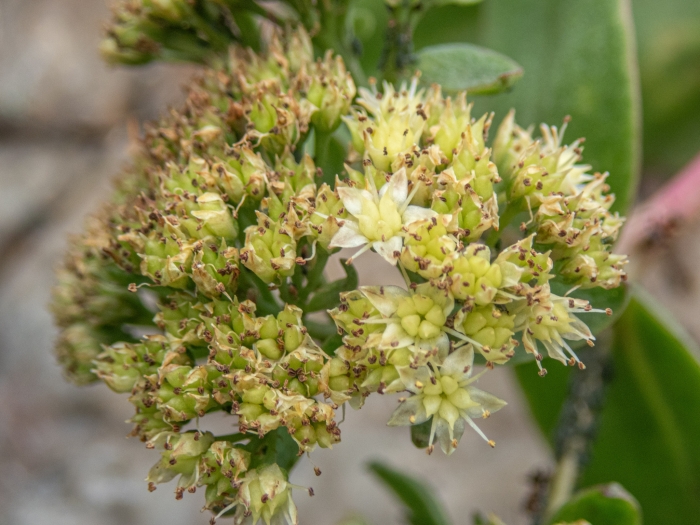Orpine
(Hylotelephium maximum)
Orpine (Hylotelephium maximum)
/
/

Don Loarie
CC BY 4.0
Image By:
Don Loarie
Recorded By:
Copyright:
CC BY 4.0
Copyright Notice:
Photo by: Don Loarie | License Type: CC BY 4.0 | License URL: http://creativecommons.org/licenses/by/4.0/ | Rights Holder: Don Loarie | Publisher: iNaturalist | Date Created: 2023-10-04T13:52:07-07:00 |

















Estimated Native Range
Summary
Hylotelephium maximum, commonly known as Orpine, Livelong, or Stonecrop, is a perennial succulent plant native to rocky outcrops, grasslands, and open woodlands across Europe and Asia. It typically grows at a moderate rate to a height and width of 1.5-2 feet (0.46-0.6 meters), forming clumps of fleshy, gray-green leaves. During the summer, it produces clusters of star-shaped, pink flowers that are quite showy and attract pollinators such as bees and butterflies. The plant is deciduous, with foliage that dies back in the winter.
Orpine is valued for its drought tolerance and ease of maintenance, making it a popular choice for rock gardens, green roofs, and as ground cover in xeriscaping. It is also used in borders and as an accent plant in succulent gardens. This Stonecrop species thrives in full sun to part shade and prefers medium to fast-draining soils, including clay, loam, or sandy types. It requires low amounts of water, reflecting its adaptation to dry habitats. While generally pest-free, it can be susceptible to root rot if overwatered or planted in poorly draining soils. It is not known to have aggressive roots or significant disease problems. Gardeners should be aware that although it is not typically invasive, it can spread readily in favorable conditions.CC BY-SA 4.0
Orpine is valued for its drought tolerance and ease of maintenance, making it a popular choice for rock gardens, green roofs, and as ground cover in xeriscaping. It is also used in borders and as an accent plant in succulent gardens. This Stonecrop species thrives in full sun to part shade and prefers medium to fast-draining soils, including clay, loam, or sandy types. It requires low amounts of water, reflecting its adaptation to dry habitats. While generally pest-free, it can be susceptible to root rot if overwatered or planted in poorly draining soils. It is not known to have aggressive roots or significant disease problems. Gardeners should be aware that although it is not typically invasive, it can spread readily in favorable conditions.CC BY-SA 4.0
Plant Description
- Plant Type: Succulent
- Height: 1.5-2 feet
- Width: 1.5-2 feet
- Growth Rate: Moderate
- Flower Color: Cream, Green
- Flowering Season: Summer
- Leaf Retention: Deciduous
Growth Requirements
- Sun: Full Sun, Part Shade
- Water: Low
- Drainage: Medium, Fast
Common Uses
Bee Garden, Border Plant, Butterfly Garden, Drought Tolerant, Fire Resistant, Groundcover, Low Maintenance, Rock Garden, Showy Flowers
Natural Habitat
Native to rocky outcrops, grasslands, and open woodlands across Europe and Asia
Other Names
Common Names: Livelong, Stonecrop
Scientific Names: , Hylotelephium maximum, Anacampseros calcareus, Sedum telephium subsp. maximum, Sedum telephium var. delphinense, Sedum telephium var. majus,
GBIF Accepted Name: